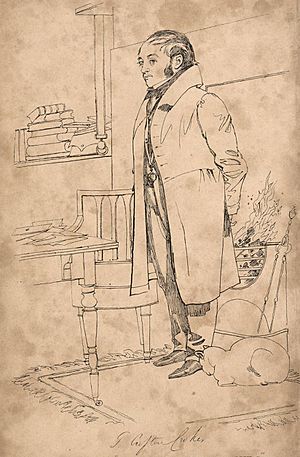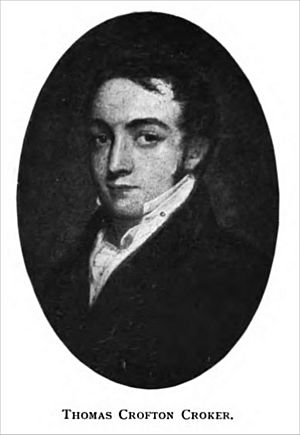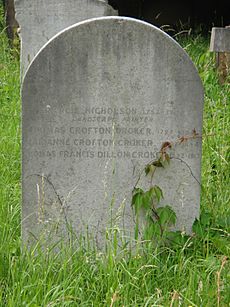Thomas Crofton Croker facts for kids

Thomas Crofton Croker (15 January 1798 – 8 August 1854) was an Irish antiquary, best known for his Fairy Legends and Traditions of the South of Ireland (1825–1828), and who also showed considerable interest in Irish song and music.
Although Fairy Legends purported to be an anthology of tales Croker had collected on his field trips, he had lost his manuscript notes and the work had to be reconstructed with the help of friends. He did not acknowledge his debt satisfactorily in the estimation of Thomas Keightley, who voiced his complaint publicly, and soon published his own rival work. The other collaborators generally allowed Croker to take credit, notably William Maginn, though after his death his kinsmen insisted Maginn had written four or more of the tales. Croker retracted ten tales in his third edition of (1834), and after his death, a fourth edition (1859) appeared which was prefaced with a memoir written by his son.
William Butler Yeats, who appropriated a number of tales for his anthology, characterised Croker as belonging to the class of the Anglo-Irish ascendancy, and criticised him for comic distortions of the Irish tradition, an assessment echoed by other Irish critics. Bridget G. MacCarthy wrote a biographical paper that scrutinises Croker's habit of publishing writings by others under his own name. Defenders of Croker include Justin McCarthy and Neil C. Hultin.
Contents
Life and works
Croker was born in the city of Cork, the only son of Major Thomas Croker and his wife, the former Miss Dillon, daughter of Croker Dillon and widow of a Mr Fitton. At age 15, he apprenticed in business. During the years 1812 to 1815, he travelled the south of Ireland and began collecting legends and songs. Croker took one Irish coronach (keening) that he collected in Cork in 1813, and translated it into English prose, which was published in the Morning Post in 1815 and caught the attention of the poet George Crabbe in 1817, through the intermediary of the antiquary Richard Sainthill.
Croker also showed talent as an artist, and his works were exhibited at Cork in 1817 ("pen-sketches of pilot-boats"), but he abandoned art in favour of literary pursuit.
Around 1818, he sent to the poet Thomas Moore a set of about forty ancient Irish air or songs, and some collected poetry, and Moore used the material in editions of his Irish Melodies.
After his father's death on 22 March 1818, the estate was managed by his distant relative (or of no relation), John Wilson Croker who was then Secretary of the Admiralty, and who procured him a position as a clerk there, a position he would retain for thirty years until his retirement in 1850.
He was a man of short stature, measuring 4 feet 10½ inches tall, and described by Sir Walter Scott as "Little as a dwarf, keen-eyed as a hawk and of very prepossessing manners—something like Tom Moore".
Croker eventually devoted himself largely to the collection of ancient Irish poetry and Irish folklore.
Researches in the South of Ireland
Croker's first book, Researches in the South of Ireland (1824), was well-received by fellow-antiquaries. According to Croker in his preface, the book was illustrated with pencil drawings by Miss Nicholson and Alfred Nicholson (1788–1833) (his future wife and brother-in-law) who accompanied him on the field trip gathering material.
Fairy Legends
Researches was followed by Fairy Legends and Traditions of the South of Ireland (1825–1828), which enjoyed immense popular success. This would be Croker's most important work. Walter Scott praised the book in a letter, and commended it in his own works.
The first part was published in 1825; and was translated into German by the Brothers Grimm (Irische Elfenmärchen, 1826). Parts two and three followed in 1828. Part three consisted of the long Grimm essay on fairies (prefaced to the Elfenmärchen) Croker translated, coupled with a section on Welsh fairy tales written by an unidentified female correspondent.
The first edition of Fairy Legends was illustrated with woodcuts by W. H. Brooke; while the second edition was supplied with original drawings by Cork's Daniel Maclise, though undergoing stylistic modifications by the engraver, Brooke. The third edition, three volumes in one was published in 1834. The work went through a total of six editions during the 19th century.
It was instrumental in attracting a wider audience to traditional Irish tales, not just within the English-speaking world, but farther abroad. However, Croker modified the tales according to his own inclinations, and has been criticised for adding too literary a style, and contrived humour to the tales.
Daniel O'Rourke on stage
Croker adapted the tale "Daniel O'Rourke" into a Christmas Pantomime under the title "Harlequin and the Eagle", and performed in 1826 at the Adelphi Theatre, for the sake of actor Daniel Terry. The actor had obtained ownership of the theatre, with considerable financial backing from Walter Scott, who was a friend of the actor's. Scott lavished praises on the pantomime at a meeting with Croker. Though it has been told anecdotally that it was Scott's idea to turn this into a play, Croker had this notion earlier, as evidenced in his notes to Fairy Legends. The play was published as Daniel O'Rourke, or Rhymes of a Pantomime, with a second edition appearing in 1828.
Noviomagus
In 1828, Croker participated in an excavation of the Roman site Noviomagus in Kent, and together with some members of the Society of Antiquaries, formed a club named "Noviomagian Society", for which Croker was voted president.
Legends of the Lakes
Croker's third book, Legends of the Lakes; or, Sayings and Doings at Killarney (1829) was both a critical and commercial disappointment. It was written in the form of a guided tour through the landscapes of at Killarney, interspersed with legends told in the dialect of the peasantry. He also featured discussions of the music of his friend the Irish piper James Gandsey, of some interest to bagpipe or uilleann pipe musicology.
Later life
Croker married in 1830 Marianne Nicholson (1792–1854), daughter of Francis Nicholson. T. F. Dillon Croker FSA, FRGS, was their son and only child.
Croker assisted in founding the Camden Society (1838) and Percy Society (1840).
He edited The Keen of the South of Ireland (1844) for the Percy Society. The first item in this collection (in the preface) was a keen composed in Irish by the mother of Flory Sullivan, collected in Gougane Barra, Co. Cork in 1813. Croker's translation of it into English got published in the Morning Post in 1815, as already noted above, and caught the notice of poet George Crabbe in 1817. It was an earlier version which was shown to Crabbe in correspondence, but on Crabbe's advice, Croker had revised the translation to a more simplified version, more in keeping with the original Irish. B. G. MacCarthy notes that he did not actually translate the keen himself but pass off the labour of native Irish informants such as Mrs. Harrington as his own, and when left to his own devices, Croker "merely revealed ignorance" of the Irish language.
He and his wife's testimonies about funereal customs, particularly the tradition of keening the deceased are among the earliest and most significant contributions to the understanding of the Irish language lament and the accompanying traditions.
Croker died in Old Brompton, London, England on 8 August 1854, and lies buried in Brompton Cemetery. His wife survived him but briefly, passing away on 6 October 1854.
List of works
According to Croker's son, Barney Mahoney (2nd ed., 1832) and My Village versus our Village (1833) were actually written by Croker's wife, Marianne.
- Researches in the South of Ireland (1824)
- Fairy Legends and Traditions of the South of Ireland, 3 vols. (1825–28)
- Daniel O'Rourke, 2nd ed. (1828)
- Legends of the Lakes, or Sayings and Doings at Killarney (1829)
- Popular Songs of Ireland (1839)
- The Keen of the South of Ireland (1844)
- Popular Songs, Illustrative of the French Invasions of Ireland, Parts I–IV. (1845–1847), repr. (1847)
Additional titles, and notices of the journals he had contributed to, are listed by Croker's son.




